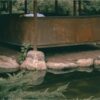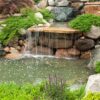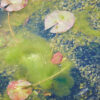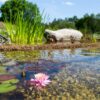What types of aquatic plants to choose for a natural swimming pool? How do I choose the best plants to filter my pool?
A Natural Swimming pool – Surrounded by aquatic and exotic lands is a fantasy for many. With some thought, planning, and hard work, this dream can become a reality. Also, using natural products and materials is the easiest way to create your natural swimming pool. This is about making a beautiful oasis that will provide you with a serene and soothing environment that you enjoy year-round.
In this article, I interviewed an expert in the field, Corentin, who has been working in an aquatic nursery for about ten years. Thanks to his experience, he helped me realize this micro-guide to list the aquatic plants recommended for your natural pool. As a result, these aquatic plants allow you to improve the water quality and improve your pond’s natural balance. These plants make it possible to strongly decrease the contribution of products to balance the water.
These plants feed on phosphates and nitrates contained in the water. These tend to reinforce the presence of algae (unicellular and filamentous), fortunately, the plants are there to eat the food of the algae and limit their development.
Two Main Families Of Plants
For a natural swimming pool with lagoons, it is most significantly important to select suitable phyto-repellent plants. There are two main families of plants that are important for your pond, swimming pool, or natural bath:
Oxygenating Plants: Oxygenating plants are aquatic plants that mature entirely and mostly under water. During photosynthesis, these submerged plants provide dissolved oxygen to the water. Fish and other marine organisms use dissolved oxygen to survive.
Marsh Plants (lagoons): Another type of plant that “belong” in the lagoon (in the wetlands) is low-growing and salt-tolerant, with floppy stems and unique ways of growing in salty soil and removing excess salt.
Types Of Aquatic Plants For Your Natura Swimming Pool
These plants allow to filter excess nutrients or polluting elements. It is an excellent solution for an ecological purification system. Moreover, many houses not connected to the sewage network install this type of principle, filtration by plants. Your water is renewed naturally. It is recommended to couple the lagoon system to a filtration system to limit the accumulation of sludge in a lagoon.
This also reduces the frequency of maintenance of your lagoon. Consequently, some lagoons are designed without access to the bottom. The problem with this type of lagoon is that it must be cleaned every 5 to 10 years. Also, the lava stones fill up with material, and it becomes unavoidable to clean. Ask our advice or that of a specialist if you want to build your lagoon. Also, think about creating a lagoon area representing at least 30% of the pond’s total volume.
Role Of Aquatic Plants In Your Natural Swimming Pool
Often, too much importance is given to the plant’s aesthetic aspect rather than to its capacity to absorb nutrients. In phytoremediation plants, bacteria present on the roots absorb organic residues. Also, these bacteria feed on different elements. This organic matter is then transformed into nutrients for the entire ecosystem.
These plants assimilate nitrogen and phosphate, which is the source of their development. Ammonium, which can weaken your pool’s aquatic environment, is also eliminated by the purifying plants that assimilate the surplus. These plants will regulate the nitrogen cycle of your ecological pool.
List of purifying plants for your pond
Among these plants, you will find the water hyacinth, or typha, both filtering and decorative. So Beware, water hyacinth, or lettuce are plants that rarely hold up in winter in Europe. Furthermore, you can also turn to stratiotes aloides (water catnip) which are real nitrate pumps.
In conclusion, Here is a list of plants with an important power of absorption of nutrients such as phosphates, nitrates, nitrogen, phosphorus, and heavy metals.
- Acorus calamus (variegated variety)
- Alisma Plantago (easy to plant) also called water plantain or frog breed is a perennial plant, resistant to cold, with oval leaves.
- Butomus (decorative pink umbel)
- Caltha palustris, or water marigold, has pretty yellow flowers, similar to buttercups, which bloom in spring from March to May, and sometimes until August. This plant is resistant to the cold, it is common to the north of Europe, and to North America.
- Sedges (all species)
- Cyperus (be careful with EPDM tarps).
- Glycera maxima
- Hippuric Vulgaris
- Iris (all species).
Some Other Plants:
- Juncus inflexcus
- Mentha aquatica brings a lot of freshness to the pond. However, like the Phragmites, this plant is invasive and therefore requires more maintenance.
- Menyanthes trifoliata
- Nasturtium officinale (watercress)
- Pontederia cordata
- Ranunculus flammula (yellow flowering)
- Preslia cervina
- Sagittaria japonica
- Saurus cernuus
- Stratiotes
- Typha (all species of broad-leafed and fine-leafed cattail): Thypha Angustifolia, or pond reed, is an herbaceous, perennial, hardy, and cold-resistant plant. It adapts to all climates, and also serves as an element of aquatic decoration.
- Veronica beccabunga
- Zizania latifolia (large vegetation in the basin)














Pingback: Maintenance for Natural Swimming Pools